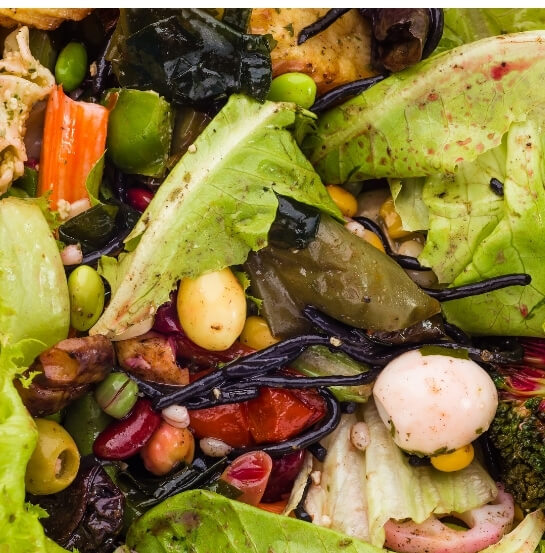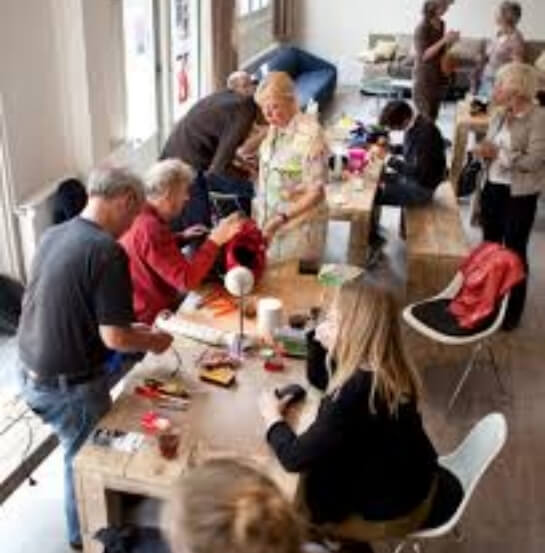- Blog
- Good practices
- Zero Waste and SDGs: shared goals

Zero Waste and SDGs: shared goals
- 09/25/2020
- Magda Cebrián
Navega por la publicación
To ensure a sustainable future, it is essential to make better use of resources . This requires a transition to an economic and social model that moves away from the widespread waste and profligacy of the current system and instead embraces circularity and regeneration.
What is the relationship between the Zero Waste movement and the SDGs?
In many ways, they are united by the will and vision to ensure a sustainable present and future for all through changes on an individual and global scale.
On the one hand, Zero Waste promotes a set of ideas and initiatives focused on waste prevention and reduction, especially on an individual scale, but which has a global impact as a movement.
On the other hand, the 17 Sustainable Development Goals (SDGs) are the United Nations’ roadmap for the period 2015-2030, which involves all stakeholders in society.

Zero waste product kit
SDG 2. Zero Hunger
Half of the world’s population already lives in urban areas, a figure that will rise to 60% by 2030 and nearly 70% by 2050, according to UN projections. These urban areas will consume more than half of the world’s resources.
One way to achieve resilient communities is to reduce their dependence on external resources through more efficient use of the resources already circulating within the community.
Materials such as organic waste, plastics, tires, electronic waste, and even fecal waste can once again become resources for the community itself with the right system that guarantees and incentivizes their optimal recovery and processing.
In this way, and as advocated by the Circular Economy, we have the opportunity to empower communities to move from a scenario where resources are sources of public spending, health risks, and lack of space, to a scenario where different byproducts are valuable to the community itself and contribute to meeting its needs, creating a local economy, and reducing greenhouse gas emissions and economic dependence on foreign countries.

Organic waste that could be converted into fertilizer
Zero Waste Actions for More Sustainable Communities
Community composting ♻️ to take advantage of organic waste.
Waste collection and recycling projects like Plastic Bank. 🔄
Resource libraries 📚 like Libraries of things .
Green points and local recycling centers . 🗑️
Repair services 🛠️ such as Repair Cafés .
Fixed and mobile markets selling local and seasonal produce. 🥕
Education and access to reusable menstrual hygiene products such as cups, cloth pads, and menstrual panties at affordable prices. 🩸
Awareness and community outreach campaigns on reduction, reuse, and prevention. 🗣️

Image of one of the 3,741 Repair Cafés in the world
ODS 12: Producción y consumo sostenibles
El undécimo objetivo de la ONU es garantizar modalidades de consumo y producción sostenibles.
La cultura del «usar y tirar» y los productos de un solo uso son grandes consumidores de recursos y grandes generadores de residuos.
Optando por productos duraderos, reparables, reutilizables y 100% reciclables se consigue una vez más un uso más eficiente de nuestros ilimitados recursos.
Para ello, son importantes conceptos como el ecodiseño y el fin de la obsolescencia programada.
El consumo y la producción sostenibles consisten en hacer más y mejor con menos. También se trata de desvincular el crecimiento económico de la degradación medioambiental, aumentar la eficiencia de recursos y promover estilos de vida sostenibles.
El consumo y la producción sostenibles también pueden contribuir de manera sustancial a la mitigación de la pobreza y a la transición hacia economías verdes y con bajas emisiones de carbono.
ODS 12 – Naciones Unidas

Fairphone, a brand of easily repairable smartphones
SDG 12: Sustainable production and consumption
Reduce material needs . 📉
Opt for durable, repairable, reusable , 100% recyclable, and toxic-free products. ♻️
Maximize the lifespan of products . ⏳
Repair whenever possible . 🛠️
Reuse . 🔄
Compost organic matter 🥔 whenever possible.
Focus on local, seasonal produce . 🥕
Reduce and reject single-use products . 🚫
Invest in trade-in and second-hand . 🤝

Second hand
Zero Waste Actions for the Protection of Ecosystems
Avoid single-use products . 🚫
Cleanup activities such as beach cleanups and plogging . 🧹
Sustainability is a cross-cutting element 🌍 across all the SDGs, and the efficient use of resources is a key element.
Support local or community composting . 🥕 Composting diverts organic waste from landfills, where it produces methane, a potent greenhouse gas.
Reduce your consumption of meat and dairy products . The production of these foods has a large water and carbon footprint. Opting for a more plant-based diet can reduce the environmental impact.
Choose sustainable modes of transportation . 🚲 Bike, walk, or use public transportation instead of driving to reduce CO2 emissions.
Buy secondhand or trade in products . ♻️ Extending the lifespan of items reduces the need to manufacture new ones, saving energy and resources.
Use eco-friendly, non-toxic cleaning products . 🧼 Chemicals in conventional cleaners can contaminate wastewater and harm aquatic ecosystems.
Promote and participate in the circular economy . 🔄 Support companies that design products to be reused or recycled, closing the materials loop and minimizing waste.
Plant trees and native vegetation . 🌳 This helps restore habitats, capture carbon, and prevent soil erosion.
Reducing water consumption at home . 💧 Small gestures like shorter showers or fixing leaks have a big impact on conserving this vital resource.

A direct action is the cleaning of beaches
Estos son algunos de los objetivos del movimiento Residuo Cero:
Reduce waste generation to a minimum . 🗑️
Apply the expanded 3 R hierarchy : rethink, redesign, reject, reduce, reuse, repair, recycle… 🔄
Promote reuse over single-use options. ♻️
Exercising the right to repair something that has been damaged. 🔧
Avoid food waste . 🍏
Opt for compostable organic matter. 🍂
Avoid the use of toxic products . 🧪
Reduce plastic pollution in all its forms and causes.
Opt for local, low-impact products . 🥕
Extend the useful life of things as much as possible . ⏳
The best waste is the one that is not generated . ✨
Before recycling, you have to reuse , and before reusing, you have to reduce. 💡
The transition from a linear to a circular economic model . 🟢
Shifting the perspective from “waste” to “resources .” 💡
The importance of composting for the reuse of all organic matter. 🍂
The fight against food waste . 🍽️
Improving the energy efficiency of appliances . ⚡️
Reducing food waste . 🥑
Better resource management . 🌳
Raising consumer awareness about more sustainable lifestyles. 🗣️
Provide accurate and appropriate information to empower consumers. 🧠
Reduce food waste , as it is estimated that one-third of the world’s food is wasted. 🌍
Summary and conclusions
The Zero Waste movement and the Sustainable Development Goals (SDGs) are closely linked by their shared objective of ensuring a sustainable future through individual and global change. Both promote a transition toward a circular economic model that moves away from waste and focuses on the efficient use of resources.
✅ SDG 2 – Zero Hunger: This goal can be achieved by viewing organic waste as a valuable resource for the community, thus creating a local economy and reducing external dependence.
✅ SDG 12 – Sustainable production and consumption: This goal aligns directly with the Zero Waste principle of reducing consumption and planned obsolescence. It encourages the use of durable, repairable, and reusable products.
✅ Expanded hierarchy of the “Rs”: The movement goes beyond recycling. It emphasizes rethinking, redesigning, rejecting, reducing, reusing, and repairing as priority actions before recycling.
✅ Actions for community sustainability: The text highlights initiatives such as community composting, Repair Cafés , local product promotion, and resource libraries, which strengthen communities and reduce their environmental impact.
✅ Actions to protect ecosystems: Concrete actions are promoted, such as avoiding single-use products , participating in cleanups, reducing meat consumption, and using sustainable transportation.
✅ Shift in mindset: The ultimate goal is to shift from “waste” to “resources” to achieve more efficient and conscious management that benefits both people and the planet.
✅ Reducing food waste: The importance of combating food waste is mentioned repeatedly, as it is estimated that one-third of food globally is wasted, making it a crucial goal for both movements.
Related news
The importance of sustainability in human resources
Sustainability has become a fundamental pillar in all areas of an organization, including Human Resources (HR). Today we explain why, its benefits, and practical examples.
How can we reduce the amount of waste we generate?
Did you know that you can reduce the amount of waste your business generates with simple and affordable alternatives?
What is a sustainable restaurant?
Eating well can be a way to care for the planet. Sustainable restaurants adopt responsible practices, eliminate waste, and are committed to the environment and the community. Want to know…



